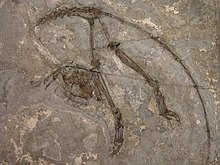| Archicebus Temporal range: Early Eocene,
| |
|---|---|

| |
| Holotype | |
| Scientific classification | |
| Domain: | Eukaryota |
| Kingdom: | Animalia |
| Phylum: | Chordata |
| Class: | Mammalia |
| Order: | Primates |
| Suborder: | Haplorhini |
| Infraorder: | Tarsiiformes |
| Family: | †Archicebidae Ni et al. 2013 |
| Genus: | †Archicebus Ni et al. 2013 |
| Species: | †A. achilles
|
| Binomial name | |
| †Archicebus achilles Ni et al. 2013
| |
Archicebus is a genus of fossil primates that lived in the early Eocene forests (~55.8–54.8 million years ago) of what is now Jingzhou in the Hubei Province in central China, discovered in 2003.[1][2] The only known species, A. achilles, was a small primate, estimated to weigh about 20–30 grams (0.7–1.1 oz), and is the only known member of the family Archicebidae. When discovered, it was the oldest fossil haplorhine primate skeleton found,[3][4] appearing to be most closely related to tarsiers and the fossil omomyids, although A. achilles is suggested to have been diurnal, whereas tarsiers are nocturnal. Resembling tarsiers and simians (monkeys and apes), it was a haplorhine primate, and it also may have resembled the last common ancestor of all haplorhines as well as the last common ancestor of all primates.[5] Its discovery further supports the hypothesis that primates originated in Asia, not in Africa.[6]
- ^ Ni et al. 2013, pp. 2 (sup).
- ^ Lei, Zhang; Fang, Qi (June 6, 2013). "I have scientists discovered the oldest fossil primate skeleton [Google translate]". Ifeng.com. Retrieved June 10, 2013.
- ^ Cite error: The named reference
NYT-20130605was invoked but never defined (see the help page). - ^ Cite error: The named reference
TG-20130605was invoked but never defined (see the help page). - ^ Cite error: The named reference
CNN-20130605was invoked but never defined (see the help page). - ^ Cite error: The named reference
SCN-20130605was invoked but never defined (see the help page).